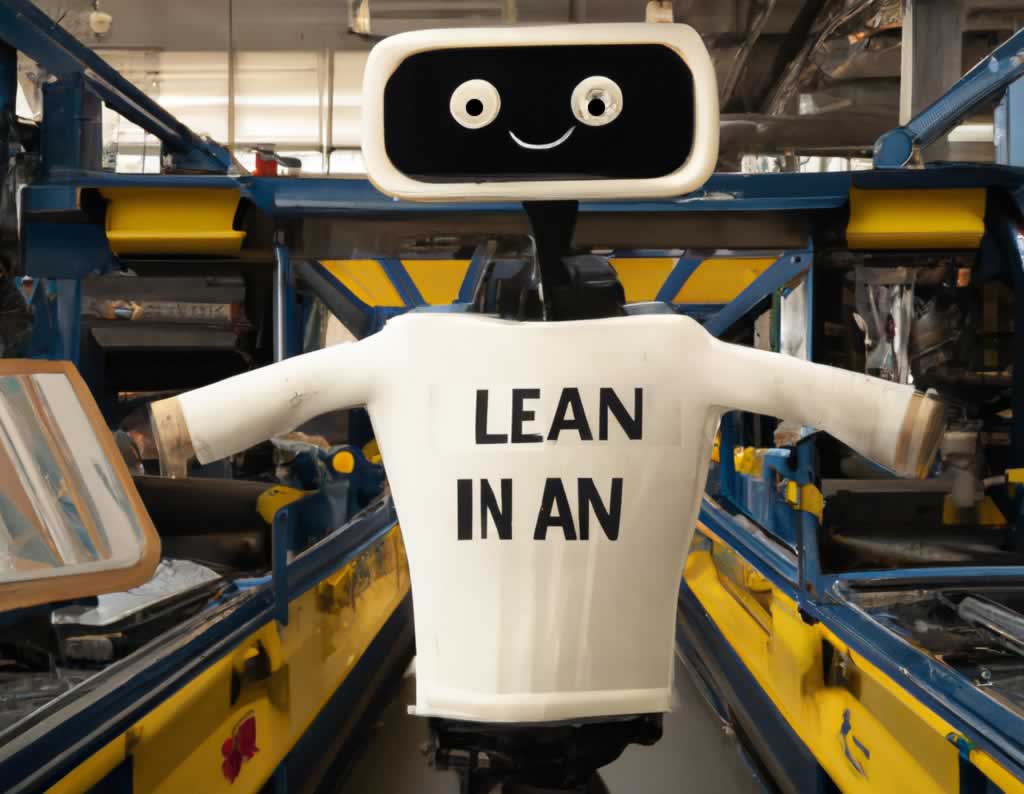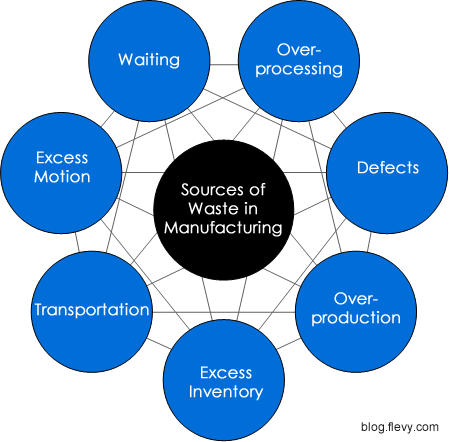Editor's Note: Take a look at our featured best practice, Kaizen (254-slide PowerPoint presentation). Explore the evolution of Kaizen, a transformative strategy originating in the 1980s that has revolutionized the success of renowned Japanese companies like Toyota. Beyond a conventional management concept, Kaizen is a dynamic and contemporary approach to achieving continuous improvement, [read more]
Eliminate Non-Value Added Activities in Your Organization
Also, if you are interested in becoming an expert on Process Improvement, take a look at Flevy's Process Improvement Frameworks offering here. This is a curated collection of best practice frameworks based on the thought leadership of leading consulting firms, academics, and recognized subject matter experts. By learning and applying these concepts, you can you stay ahead of the curve. Full details here.
* * * *
Recession or boom, companies need to sharpen their competitive edge by applying Lean Management principles to Cost Reduction—that is, the elimination of non-value-added activities or waste in the value stream processes.
Be Lean
In the Lean Management philosophy, all activities in an organization are grouped into two categories:
- value-added (VA) activities, and
- non-value-added (NVA) activities.
In the context of Lean Management, VA and NVA activities are viewed from the customer’s perspective.
Value adding activities are those that bring additional value to products or services. Value added activities examples include entering orders, ordering materials, laying foundations, creating codes, assembling parts, and shipping of goods to customers. Customers are willing to pay for these improvements that can change the form, fit or function of a product or service.
Let’s look at a specific example with the production of smartphones. Value-added activities include those activities that transform the raw materials into the finished smartphone product, for which the customer is willing to pay. Value adding activities examples in this scenario include molding, cutting, drilling, assembling parts, etc.
On the other hand, NVA activities are tasks that do not increase market form or function. Non-value added activities examples include filing, copying, recording, waiting, counting, checking, inspecting, testing, reviewing, and obtaining approvals. These activities should be eliminated, simplified or reduced.
By tackling wastes from an end-to-end business process, not only can your company improve the value of its products and services, you can also achieve significant cost reduction, strengthen cash flow and emerge from the downturn with a stronger and more competitive profile.
7 Sources of Waste
There are seven sources of waste in a manufacturing environment. (Learn more about Lean Manufacturing here.)
Studies have shown that in a typical organization, some 90% or more of all activities fall into the NVA bucket.
Although the explanations and examples provided below may be more relevant to manufacturing industries, the concepts can be universally applied to service industries as well.
The seven sources of waste are:
1. Waiting
This is the idle time resulting from waiting for materials and information, e-mail queues from customers, delayed shipments, equipment or system downtime and so on.
2. Over-processing
This results from unnecessary procedures due to undefined customer requirements, lack of effective communication, product changes without process changes, redundant approvals, making extra copies and excessive reporting.
3. Defects
These are errors, scrap, rework, replacements, re-inspection and re-testing. The causes are incorrect data entries, poor quality, weak process control, inadequate training, deficient planned maintenance and customer needs that were not understood.
4. Excess motion
This refers to any movement of people or machines that does not add value to the product or service. Common causes are poor plant or office layout, double handling, inconsistent work methods and poor workplace organization.
5. Transportation
This refers to the transporting of parts, materials and files or documents around the plant or office. The causes are poor plant or office layout, widely spaced equipment and workstations, and poor understanding of the process flow.
6. Over-production
This happens when you make too much, too early and faster than is required by the next process. The causes include unclear goals, excessive lead times and outdated forecasts.
Tip: You should reduce your batch size to match the rate of demand. Produce exactly to customer demand, not more.
7. Excess inventory
This happens when you have more inventory than is needed for a job. It is important to tackle excess inventory as it has a huge impact on cash flow.
Tip: Review your materials purchasing strategy — where can you buy them at a cheaper price, in smaller amounts and have them delivered to you more frequently?
Eliminate the Waste
The ability to identify waste in your organization is the first step towards its elimination.
The next step is to set up problem-solving teams and enable them to reduce or eliminate the wastes. A common problem-solving technique is the PDCA (Plan-Do-Check-Act) approach. (Learn more about PDCA tools and techniques here.)
Involve your employees in problem-solving or process improvement. If they know that they are an active part of the solution, they can identify sources of waste or savings that you might not be aware of.
Do note that not all waste is of equal importance. You will need to identify the “right waste” — those that have the greatest impact on the business case or bottom line.
Continuous Process
For waste elimination to be successful and sustainable, an organization’s senior executives need to adopt a mindset that cutting waste to cut costs is an on-going journey of continuous improvement. It has to be a collaborative effort between management and employees.
A common mistake for senior executives to avoid is to treat waste elimination as another one-off “tool” or quick fix. It is essential to manage waste elimination as a strategic change initiative that is aligned to the organization’s vision, encompassing both cultural and process transformations.
Cost of Non-Value Added Activities
NVA activities may appear innocuous on the surface, but their hidden costs can accumulate over time, impacting an organization’s financial health. These costs go beyond the immediate expenses and touch various aspects of the business:
- Resource Drain: Non-value added activities tie up precious resources—time, labor, materials—that could otherwise be allocated to revenue-generating endeavors.
- Operational Inefficiency: Such activities introduce unnecessary steps, elongating process times and increasing the chances of errors, rework, and delays.
- Opportunity Loss: When employees are engaged in non-value added tasks, they’re diverted from strategic and innovative activities that drive growth and competitive advantage.
- Customer Dissatisfaction: Prolonged processes and unnecessary touchpoints lead to frustrated customers, deteriorating brand image, and lost customer loyalty.
To underline the point, consider this: a study found that non-value added activities could consume up to 80% of employees’ time. By recognizing and eliminating these activities, organizations can unlock significant operational and financial gains.
Strategic Alignment and Non-Value Added Activities
Aligning waste elimination efforts with an organization’s strategic objectives is pivotal for sustained success. Here’s how strategic alignment and waste elimination are intertwined:
- Resource Focus: Prioritize waste reduction in areas that align with the organization’s strategic goals, ensuring that resources are dedicated to endeavors that truly matter.
- Customer-Centricity: Strategic alignment ensures that waste reduction efforts resonate with customer needs and preferences, enhancing the overall customer experience.
- Innovation Facilitation: Freed resources from waste elimination can be strategically reinvested in innovation, allowing organizations to stay competitive and adapt to changing market demands.
- Holistic Improvement: Strategic alignment ensures that waste reduction isn’t isolated but permeates every facet of the organization, resulting in a cohesive culture of continuous improvement.
Strategic alignment not only maximizes the impact of waste elimination efforts, but also demonstrates that every action taken is in pursuit of the organization’s overarching vision.
Measuring the Success of Waste Elimination
Measuring the success of waste elimination initiatives is crucial to gauge the effectiveness of your efforts. Consider these metrics:
- Cycle Time Reduction: Track the time taken for processes before and after waste elimination to gauge efficiency improvements.
- Cost Savings: Quantify the direct cost savings achieved by eliminating unnecessary steps, rework, and resource wastage.
- Quality Enhancement: Measure the reduction in errors and defects resulting from streamlined processes, leading to improved overall quality.
- Employee Engagement: Gauge employee satisfaction and engagement levels as they witness the positive impact of waste elimination on their work.
- Customer Satisfaction: Monitor customer feedback and satisfaction scores to assess whether waste elimination efforts positively influence their experience.
Remember, measuring the success of waste elimination isn’t just about numbers—it’s about tangible improvements in operational efficiency, cost-effectiveness, and the overall experience for both employees and customers.
Case Studies of Successful Waste Elimination
Real-world examples vividly demonstrate the transformative power of waste elimination:
- Toyota: The pioneer of Lean principles, Toyota, eliminated waste in its production processes, resulting in reduced inventory, faster production cycles, and higher customer satisfaction.
- Amazon: Through meticulous waste reduction, Amazon optimized its order fulfillment process, enhancing customer experiences by reducing delivery times.
- GE Aviation: By targeting waste in aircraft engine maintenance processes, GE Aviation significantly improved turnaround times, reducing downtime for clients and increasing their competitive edge.
These case studies underscore that waste elimination isn’t just theory—it’s a practical approach that drives tangible benefits and competitive advantages across various industries. Executives can draw inspiration from these successes to craft tailored waste elimination strategies that suit their organization’s unique needs and objectives.
To learn more principles and frameworks of Lean Management, Cost Reduction, and Waste Elimination, please check out the author’s business documents listed on Flevy here.

Want to Achieve Excellence in Process Improvement?
Gain the knowledge and develop the expertise to become an expert in Process Improvement. Our frameworks are based on the thought leadership of leading consulting firms, academics, and recognized subject matter experts. Click here for full details.
Process Improvement involves analyzing and improving existing business processes in the pursuit of optimized performance. The goals are typically to continuously reduce costs, minimize errors, eliminate waste, improve productivity, and streamline activities.
As we continue to deal with COVID-19 and its economic aftermath, most organizations will prioritize Business Process Improvement initiatives. This is true for a few reasons. First, Process Improvement is one of the most common and effective ways of reducing costs. As the global economy slows down, Cost Management will jump to the forefront of most corporate agendas.
Secondly, a downturn typically unveils ineffective and broken business processes. Organizations that once seemed agile and focused during periods of growth may become sluggish and inefficient when demand drops off.
Lastly, COVID-19 has expedited Digital Transformation for most organizations. One of the quickest and most impactful forms of Digital Transformation is Robotic Process Automation (RPA). Thus, we have included numerous RPA frameworks within this Stream.
Learn about our Process Improvement Best Practice Frameworks here.
Readers of This Article Are Interested in These Resources

|
|
180-slide PowerPoint presentation
|
|
157-slide PowerPoint presentation
| |||
About Allan Ung
Allan Ung is a management consultant at Operational Excellence Consulting, a consultancy that focuses on maximizing customer value and minimizing wastes through Lean Management. He is also a seller at Flevy. View his documents here: OEConsulting.
Top 10 Recommended Documents on Process Improvement
» View more resources Process Improvement here.
» View the Top 100 Best Practices on Flevy.















